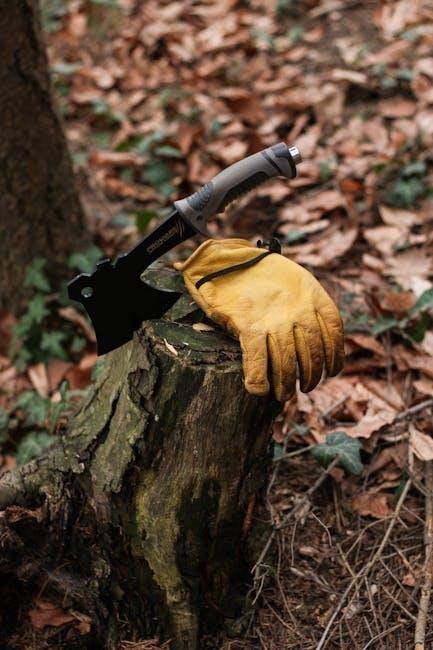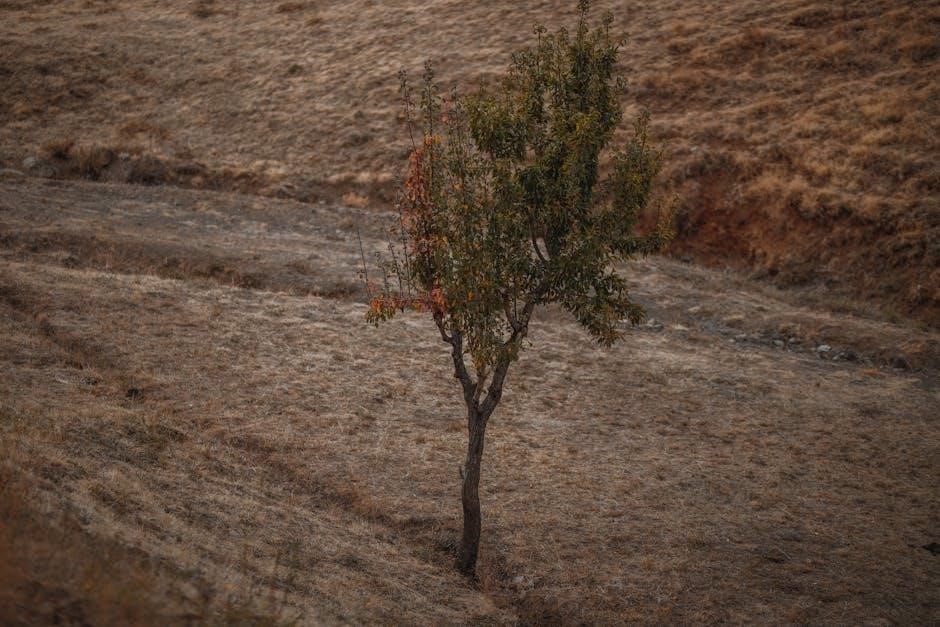
Tom Brown’s Field Guide to Wilderness Survival is a comprehensive handbook offering essential skills for navigating the wild, emphasizing awareness, tracking, and nature-based philosophies for all outdoor enthusiasts.
Overview of the Book’s Importance
Tom Brown’s Field Guide to Wilderness Survival is a seminal work that bridges traditional wilderness knowledge with modern practicality, making it indispensable for outdoor enthusiasts. Its emphasis on awareness, tracking, and nature-based philosophies provides a holistic approach to survival, ensuring readers can navigate the wild safely and respectfully. The guide is praised for its accessibility, catering to both novices and seasoned adventurers. By preserving ancient survival skills in a clear, illustrated format, the book serves as a vital educational tool for anyone seeking to connect with nature. Its timeless wisdom and practical applications make it a cornerstone resource for fostering self-reliance and environmental stewardship, ensuring its relevance for generations to come.
Tom Brown Jr.’s Expertise in Wilderness Survival
Tom Brown Jr. is a renowned expert in wilderness survival, founder of the Tracking, Nature, and Wilderness Survival School. With decades of experience, he has mastered skills passed down from his mentor, an Apache elder, blending traditional wisdom with modern techniques. His expertise spans tracking, awareness, and primitive survival methods, emphasizing harmony with nature rather than mere survival. Brown’s teachings focus on reconnecting with the natural world, fostering a deep understanding of the environment. His work has educated countless individuals, from outdoor enthusiasts to professionals, making him a trusted authority in the field of wilderness survival and environmental education.
The Book’s Target Audience
Tom Brown’s Field Guide to Wilderness Survival is designed for a wide range of readers, from seasoned outdoor enthusiasts to novice adventurers. It serves as an invaluable resource for educators, parents, and counselors seeking to teach wilderness skills to children. The guide is also tailored for nature lovers and those interested in environmental education. Its clear, accessible format makes it suitable for both beginners and experts, ensuring that everyone can learn essential survival techniques. Whether for personal growth, educational purposes, or outdoor adventures, this guide provides practical knowledge to enhance any wilderness experience, fostering safety and confidence in the natural world.
Essential Skills for Wilderness Survival
Essential Skills for Wilderness Survival covers fundamental techniques like awareness, tracking, shelter building, finding food, water sourcing, fire starting, and navigation, vital for surviving in the wild.
Awareness and Observation Techniques
Awareness and observation are foundational skills emphasized in Tom Brown’s guide, teaching readers to attune themselves to nature’s subtle cues. By sharpening sensory perception, individuals can detect hidden dangers, locate resources, and understand their surroundings. The guide highlights the importance of recognizing patterns in nature, such as animal tracks, weather changes, and vegetation shifts. These techniques enable survivors to predict potential threats and make informed decisions. Brown also stresses the value of stillness and patience, allowing individuals to blend into their environment and observe without disruption. Such practices foster a deeper connection with nature and enhance situational awareness, crucial for staying safe in the wilderness.
- Recognizing patterns in nature
- Understanding animal behavior and signs
- Enhancing situational awareness
Tracking and Its Role in Survival
Tracking is a cornerstone of wilderness survival, as emphasized in Tom Brown’s guide, enabling individuals to locate resources and navigate safely. By interpreting signs like footprints, disturbed vegetation, and animal behavior, one can identify potential threats or opportunities. This skill extends beyond following trails; it involves understanding the broader environmental context. Brown teaches that tracking fosters a deeper connection with nature, enhancing awareness and situational understanding. It allows survivors to predict animal movements, locate water sources, and even identify edible plants. Mastery of tracking not only boosts survival chances but also enriches the outdoors experience, promoting a harmonious relationship with the natural world.
- Interpreting natural signs and patterns
- Locating resources like food and water
- Enhancing environmental awareness
Shelter Building and Protection from the Elements
Shelter is crucial for protection against harsh weather conditions. Tom Brown’s guide provides detailed instructions on constructing lean-tos and debris huts using readily available natural materials like sturdy branches and layers of leaves. It stresses the importance of selecting a safe location, ideally elevated to prevent water accumulation and near a water source for convenience. The guide also covers methods for securing the shelter’s structure and adding insulation to retain body heat. By following these techniques, individuals can create a dry and stable environment that significantly enhances their chances of survival in the wilderness. The emphasis is on using nature to one’s advantage, ensuring safety and comfort.
- Constructing lean-tos and debris huts
- Using natural materials effectively
- Selecting a safe and dry location
- Securing and insulating the shelter
Finding Food in the Wild
Finding food in the wild is essential for survival, involving skills like foraging, hunting, and preparing edible plants and animals safely and sustainably.
Foraging for Edible Plants
Foraging for edible plants is a fundamental skill in wilderness survival, requiring careful identification to ensure safety and avoid toxic species. Tom Brown’s guide provides detailed instructions and illustrations to help enthusiasts recognize and harvest wild plants safely. It emphasizes the importance of understanding plant habitats, seasons, and growth patterns to locate food sources effectively. The book also highlights sustainable foraging practices to preserve ecosystems while meeting survival needs. By mastering these techniques, individuals can rely on nature’s bounty for nourishment, making foraging a vital component of self-reliance in the wild. This section empowers readers to confidently identify and utilize edible plants, ensuring a steady food supply in wilderness environments.

Hunting and Trapping Techniques
Tom Brown’s guide provides practical methods for hunting and trapping, essential for procuring food in the wilderness. It details effective techniques for setting traps, using weapons, and stalking prey while emphasizing ethical and sustainable practices. The book offers insights into understanding animal behavior, tracks, and habitats to increase success rates. Brown also covers the importance of using minimal equipment and relying on natural resources to create effective traps. These techniques are designed to ensure survival while respecting the natural balance of ecosystems. By mastering these skills, individuals can confidently hunt and trap, securing a reliable food source in challenging environments. This section is a crucial component of Brown’s comprehensive approach to wilderness survival.
Preparing Wild Foods Safely

Tom Brown’s guide emphasizes the importance of safely preparing wild foods to avoid illness and ensure nutrition. It covers techniques for identifying edible plants, cleaning game, and cooking methods to eliminate toxins. The book provides detailed instructions on how to properly handle and prepare wild foods, including boiling, roasting, and preserving. Brown also highlights the need to avoid contaminated or spoiled food sources. By following these guidelines, individuals can enjoy safe and nutritious meals in the wilderness. This section is vital for anyone seeking to sustain themselves in wild environments while minimizing health risks. The guide’s clear instructions make it accessible to both novices and experienced outdoorspeople.

Water Sourcing and Purification
Tom Brown’s guide provides essential techniques for locating water sources, purifying methods, and conserving resources, ensuring safe hydration in wilderness environments with clear, easy-to-follow instructions.

Locating Water Sources
Tom Brown’s guide emphasizes the importance of identifying water sources through observation of natural signs, such as vegetation, animal tracks, and terrain features. It teaches how to recognize areas where water naturally collects, like depressions, streams, and springs. The book highlights methods for tracking water sources in various environments, from forests to deserts, and stresses the reliability of natural indicators like moss, lichen, and certain tree species. Brown also provides practical advice on following animal trails, as they often lead to water. These techniques, honed through decades of experience, enable readers to efficiently locate water in even the most challenging wilderness conditions, ensuring hydration and survival.
Methods for Water Purification
Tom Brown’s guide details practical methods for purifying water in the wilderness, ensuring safety and preventing waterborne illnesses. Techniques include sand and charcoal filtration to remove sediment and impurities, as well as solar disinfection using the sun’s UV rays. Boiling water is emphasized as one of the most reliable methods, with instructions on how to build a fire and maintain it for this purpose. Brown also discusses natural purification using plant fibers and absorbent materials. These methods, combined with proper water sourcing, provide a comprehensive approach to securing clean drinking water. The guide’s focus on simplicity and accessibility makes it invaluable for both novice and experienced outdoor enthusiasts, ensuring hydration remains a priority in survival situations.
Conserving Water in the Wilderness
Tom Brown’s guide emphasizes the importance of water conservation, teaching readers to minimize waste and maximize efficiency; Techniques include rationing water intake, reducing sweat through shaded rest, and using cloth to absorb moisture from plants. Brown highlights the value of collecting dew or transpiration from leaves to supplement supplies. He also advises on identifying water-rich foods to reduce hydration needs. By prioritizing water conservation, individuals can extend their survival in arid or water-scarce environments. These practical strategies, rooted in Brown’s extensive experience, ensure that even limited water resources are used wisely, making this section a cornerstone of the guide’s survival philosophy.

Fire Starting and Maintenance
Tom Brown’s guide provides expert techniques for starting and maintaining fires, emphasizing the use of flint and steel, bow drills, and strategies for sustaining flames in harsh conditions.
Using Flint and Steel
Tom Brown’s guide highlights flint and steel as a reliable method for fire starting, emphasizing ancient, durable techniques. The process involves striking steel against a flint to produce sparks, which ignite tinder. Brown stresses the importance of angle and force in generating effective sparks. Proper preparation of materials, such as dry grass or shredded bark, is crucial for catching sparks and building a flame. This method, while requiring practice, is a cornerstone of wilderness survival, ensuring fire creation without modern tools. Brown also provides tips for maintaining the flint and steel, such as keeping them dry and free of debris, to ensure longevity and reliability in harsh conditions. This timeless technique is a vital skill for any outdoor enthusiast.
Creating a Bow Drill
Tom Brown’s guide teaches the art of crafting and using a bow drill, a primitive yet effective fire-starting method. This technique relies on creating friction between a spinning drill and a stationary fireboard. The bow, a flexible branch with a string, rotates the drill rapidly, generating heat. A notch on the fireboard catches the ember, which is then transferred to tinder. Brown emphasizes proper material selection, such as straight, smooth sticks for the drill and bow. Practice is key to mastering this ancient skill, essential for survival without modern tools. The bow drill method, while labor-intensive, is a reliable way to start a fire in any wilderness environment, ensuring warmth and safety in challenging conditions.

Maintaining a Fire in Harsh Conditions

Maintaining a fire in harsh conditions is crucial for survival, providing warmth, light, and a way to cook food. Tom Brown’s guide stresses the importance of protecting the fire from wind and rain by using natural shelters or constructing windbreaks. Keeping the fire small but sustainable is key, as it conserves fuel and reduces visibility. Brown advises using dry, well-seasoned wood, often found under tree bark or in elevated areas. Feeding the fire gradually ensures it burns efficiently, while clearing debris around the perimeter prevents accidental spread. Regular tending is essential to maintain flames, especially in wet or snowy environments. A well-maintained fire can be a lifeline in extreme conditions, offering both physical and psychological comfort in the wilderness.

Wilderness Philosophy and Mindset
Tom Brown’s guide emphasizes harmony with nature, teaching respect, awareness, and a deep connection to the land, fostering a mindset that blends survival skills with spiritual renewal.
Connecting with Nature
Tom Brown’s guide highlights the importance of fostering a profound connection with nature, emphasizing observation, respect, and harmony with the environment. By encouraging readers to embrace the natural world, the book teaches how to move silently, interpret signs of wildlife, and understand the interconnectedness of all living things. This approach not only enhances survival skills but also cultivates a deeper appreciation for the land. Brown’s philosophy, influenced by his mentor, an Apache elder, stresses the need to blend seamlessly into nature rather than dominate it. This mindset transforms survival into a holistic experience, blending practical skills with spiritual growth and a sense of oneness with the wilderness.
The Role of Philosophy in Survival
Tom Brown’s guide underscores the profound role of philosophy in wilderness survival, emphasizing a mindset rooted in harmony with nature. Drawing from the wisdom of an Apache elder, Brown teaches that survival is not just about physical skills but also about understanding and respecting the land. This philosophical approach encourages a shift from dominance to partnership with the environment, fostering awareness and humility. By cultivating a deep connection to nature, individuals can navigate challenges with clarity and resilience. Brown’s teachings highlight how philosophy serves as the foundation for effective survival, blending practical techniques with a spiritual and ethical framework that honors the natural world and its rhythms.
Ethics of Wilderness Survival

Tom Brown’s guide emphasizes the importance of ethics in wilderness survival, advocating for a deep respect for nature and its resources. Brown teaches that survival should never come at the expense of harming the environment or depleting natural resources unnecessarily. He promotes principles of minimal impact, encouraging individuals to leave the wilderness as untouched as they found it. This ethical approach ensures that survival practices are sustainable and harmonious with nature. By adhering to these guidelines, individuals not only preserve the natural world but also foster a meaningful connection with it. Brown’s philosophy underscores the responsibility of every person to protect and honor the land while meeting their survival needs.
Advanced Survival Techniques
Tom Brown’s guide delves into advanced survival techniques, including navigation without modern tools, thriving in extreme environments, and effective signalizing methods to ensure safety and rescue.
Navigation Without Modern Tools
Navigation without modern tools is a cornerstone of wilderness survival, relying on natural signs like the sun’s position, stars, and landmarks. Tom Brown’s guide teaches how to use shadows, moss growth, and river flows to determine direction. It emphasizes understanding natural patterns, such as the North Star’s location and the movement of celestial bodies, to navigate accurately. Additionally, the book covers using topographic features like ridges and valleys to stay oriented. These timeless methods ensure reliability in emergencies, fostering self-reliance and deepening one’s connection with nature. Brown’s teachings highlight the importance of awareness and observation, making navigation without modern tools both practical and empowering for any wilderness adventurer.
Surviving in Extreme Environments
Tom Brown’s guide provides expert strategies for surviving in extreme environments, such as deserts, arctic regions, and dense jungles. It emphasizes adapting to climate-specific challenges, like managing hydration in scorching deserts or retaining body heat in freezing conditions. The book offers practical advice on constructing shelters using natural materials, such as snow walls or leaf-covered frameworks, to protect against harsh weather. Additionally, it covers techniques for finding or creating water sources, even in arid landscapes, and methods to start fires in damp or frigid settings. Brown also stresses the importance of mental resilience and understanding how to signaled for help when necessary. These skills ensure survival in the most unforgiving wilderness conditions.
Signalizing for Help
Tom Brown’s guide emphasizes the critical importance of signaling for help in wilderness survival. It teaches various methods to alert rescuers, such as creating smoke signals during the day and building large fires at night. The book also highlights the use of reflective surfaces, like mirrors or shiny objects, to catch the attention of aircraft or distant observers. Additionally, Brown provides techniques for constructing ground signals, such as arranging rocks or branches in visible patterns. He stresses the need to stay visible and maintain hope, as signaling effectively can be the key to rescue. These strategies ensure that even in remote areas, one can communicate their location to potential rescuers, increasing chances of survival.
Tom Brown’s Field Guide to Wilderness Survival empowers readers with timeless skills, fostering a deeper connection with nature and ensuring preparedness for any outdoor challenge.
Final Thoughts on Wilderness Survival
Tom Brown’s Field Guide to Wilderness Survival offers a profound understanding of living in harmony with nature. By mastering essential skills like awareness, tracking, and shelter-building, readers gain confidence to thrive in the wild. The guide emphasizes a philosophy of respect and connection with the environment, taught through clear illustrations and practical instructions. It serves as a vital resource for both novices and experienced outdoorsmen, ensuring safety and self-reliance. Brown’s teachings encourage a deeper appreciation for nature’s beauty and resilience, making the guide a timeless companion for any wilderness adventure. Its ethical approach reminds us that survival is not just about techniques, but about living in balance with the land and its creatures, fostering a mindset of harmony and preservation for future generations to embrace.
Encouragement for Further Learning
Tom Brown’s Field Guide to Wilderness Survival inspires readers to explore beyond its pages, encouraging a deeper connection with nature and continuous skill development. The guide serves as a foundation, motivating learners to practice and refine their abilities in real-world settings. It emphasizes the importance of hands-on experience, urging readers to venture into the wilderness and apply the techniques learned. By fostering a mindset of curiosity and respect for the natural world, the book empowers individuals to seek out additional resources, attend workshops, and join communities dedicated to wilderness survival. This journey of learning not only enhances survival skills but also cultivates a lifelong appreciation for the beauty and resilience of nature, ensuring that the wisdom shared in the guide is passed on to future generations.